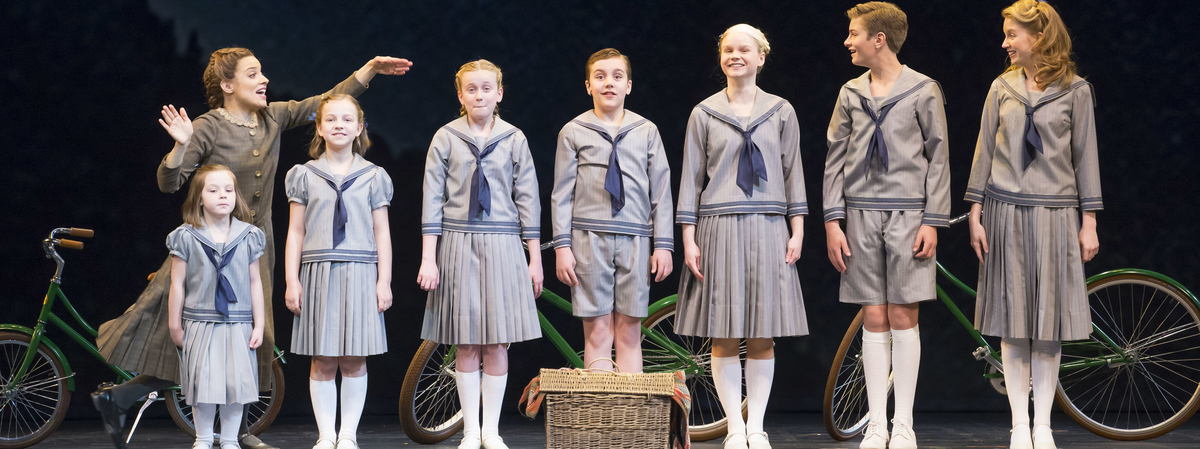May 29, 2020
Something Good: the joys of THE SOUND OF MUSIC
It was in a Broadway theater in 1959 that audiences first fell in love with The Sound of Music. The love affair continues unabated, thanks to an eternally captivating story and the songs that have carved such a firm niche in the hearts of listeners everywhere.
The Sound of Music is the last of the Rodgers and Hammerstein musicals. Only once before (in The King and I, based on the real-life experiences of a Welsh governess in Siam) had they presented characters onstage who actually lived. Yes, there are major differences between the true events and what we see onstage, but also much is the same—above all, the importance of music in bringing a family together and sustaining their spirit.

Jenn Gambatese as Maria with the von Trapp children in Lyric's 2013/14 production of The Sound of Music.
The real story behind The Sound of Music began with Georg von Trapp, an Austrian aristocrat who served as a submarine captain during World War I. His outstanding leadership prompted a grateful country to bestow on him the title of Baron. He grew depressed after the war, given that the Austrian navy essentially ceased to exist. Georg wasn’t inclined to pursue a full time occupation, but luckily his young wife, Agathe Whitehead, came from a well-to-do British family (her grandfather, Robert Whitehead, had invented the torpedo). The youngest of their seven children hadn’t yet passed her first birthday when Agathe died of scarlet fever in 1922, leaving the family devastated. Attempting to start anew with the children in an environment not burdened by sad memories, Georg resettled in a villa in Salzburg. Four years later a 21-year-old postulant from Nonnberg Abbey entered their lives and stirred things up, to say the least.
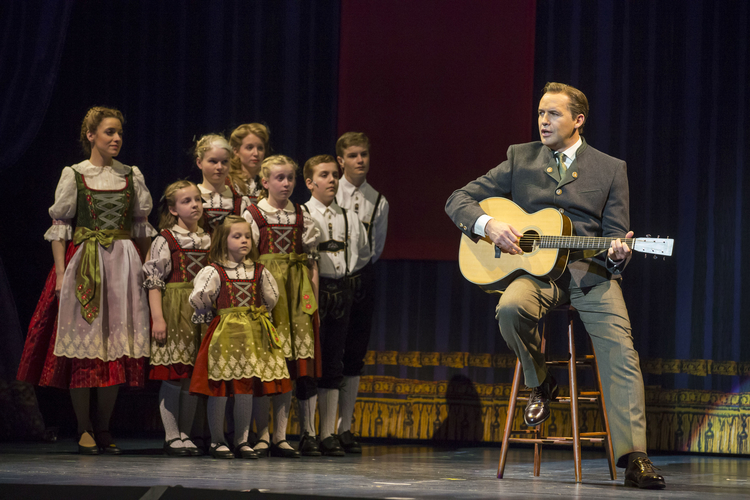
Billy Zane as Georg von Trapp sings "Edelweiss" in Lyric's 2013/14 production of The Sound of Music.
Like her onstage incarnation in The Sound of Music, Maria Augusta Kutschera (her surname in the show changed to the easier-to-pronounce “Rainer”) was a headstrong young woman. She’d had a tough life, with her mother’s premature death and a problematic relationship with her father. Raised by foster parents, she grew up sheltered and lonely. Maria also misbehaved a good deal, thus it was fortunate that she discovered religion as a teenager, giving her a vocation in life. Still, her impetuosity and irrepressibility didn’t suit the community of nuns who surrounded her. As the song says, “How do you solve a problem like Maria?” The Mother Abbess did so by justifying it as God’s will that Maria be sent off to work for Baron von Trapp—essentially, to see whether her desire to become a nun would remain steadfast during a lengthy absence from the abbey.
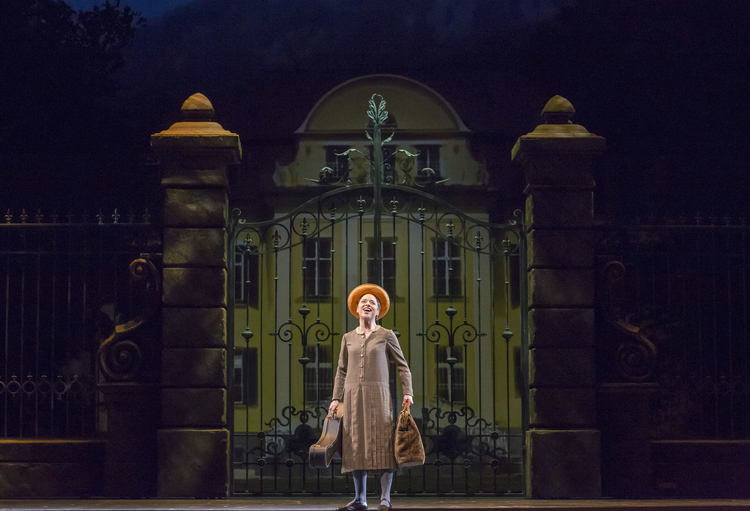
Jenn Gambatese as Maria in Lyric's 2013/14 production of The Sound of Music.
Maria left with great reluctance. Incidentally, she was hired as a teacher for only one child, rather than all seven (this was a daughter also named Maria – the last survivor of the original seven children, she died in early 2014 at age 99). Anyone familiar with “Do Re Mi” will be astonished that the children already knew how to sing and could also play various instruments. They got along well enough with Maria for Georg to propose marriage to her, despite their 25-year age difference. Desperately uncertain, Maria returned to the abbey, where she was encouraged to accept Georg’s offer. She wrote years later that when she married in the autumn of 1927, “I really married the children.” Maria didn’t love Georg at that time—only quite a while later did her love for him finally emerge. The von Trapp brood soon grew to nine, with Maria giving birth to two daughters.
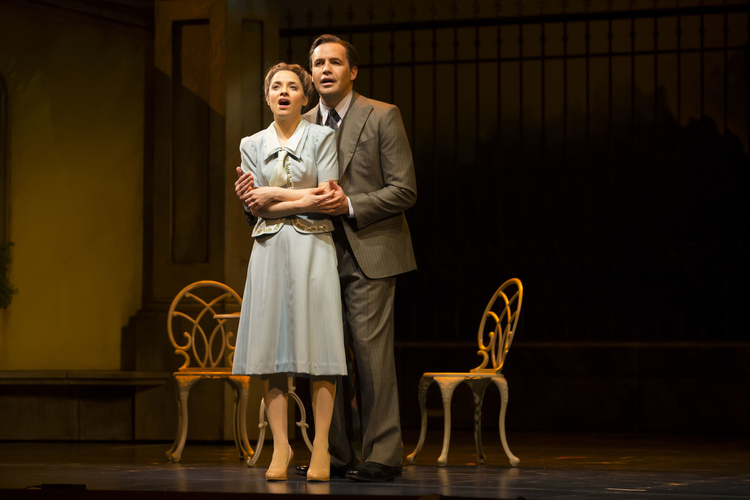
Jenn Gambatese and Billy Zane starred in Lyric's 2013/14 production of The Sound of Music as Maria and Georg.
The family had comparatively few clouds in their lives until a harrowing financial crisis struck in 1932, when the bank housing Georg’s savings collapsed. The family was now forced to live on just one floor of their villa (the others were rented). Their salvation was singing: one of their boarders, Father Franz Wasner, instructed Maria and the children (Georg did not participate), shaping their voices into a superbly accomplished choir. One of the era’s greatest sopranos, Lotte Lehmann, heard them practicing and enthusiastically encouraged them to perform. As the Salzburg Trapp Choir, they won a local competition, which led to many important opportunities outside Austria. Their programs, mixing classical and folk music, brought them huge acclaim wherever they appeared.
After Germany invaded Austria in 1938, Georg was offered a position in the Third Reich’s navy, but associating himself in any way with the Nazis was out of the question. Four months later the family left their villa and proceeded as refugees to Italy, then London, then finally the United States. Upon arrival, they were sent to Ellis Island, an unnerving experience. It was thanks to the distinguished American impresario Charles Wagner, who’d heard them in Europe, that they were able to establish themselves in this country. Beginning as the Trapp Family Choir (their manager at Columbia Concerts renamed them the Trapp Family Singers), they were an instant success.

Act one of Lyric's 2013/14 production of The Sound of Music.
Just a few months after the family arrived in America, the last of Maria and Georg’s children, Johannes, was born during a visit with friends in Philadelphia. Offered a home in Merion, Pennsylvania, the family used that as their base until, on one of their tours, they discovered the beauties of Vermont, which reminded them of Austria. In 1943, they bought a farm in the hills of Stowe, eventually rebuilding the house to create a 27-room lodge that welcomed guests beginning in 1950. Today the lodge, “Cor Unum,” rebuilt again and greatly expanded after a 1980 fire, is still owned and operated by the family.
The Trapp Family Singers performed throughout America for two decades. After Georg’s death in 1947, and with the grown children moving into their own careers, Maria chose to join her colleague, Father Wasner, as a missionary in the South Pacific. Retiring to “Cor Unum,” she remained an active, vital presence until her death in 1987. She wrote of her life in several books, including The Story of the Trapp Family Singers (the source for The Sound of Music, 1949).
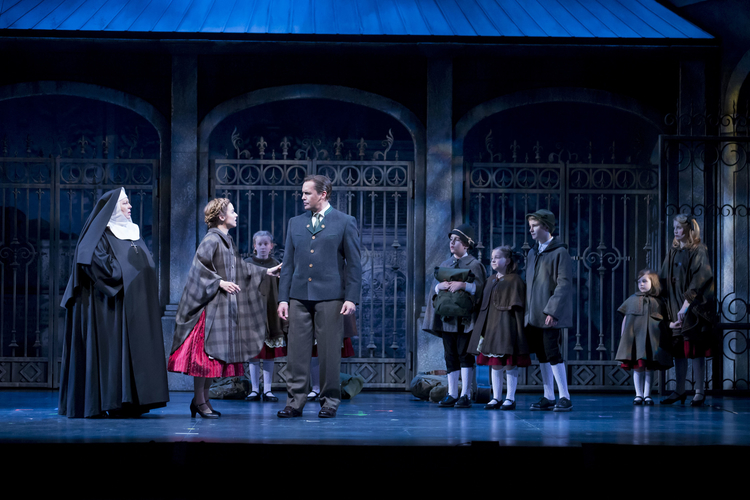
The von Trapp family in Lyric's 2013/14 production of The Sound of Music.
The von Trapps’ path from being the world’s most famous family choir to the protagonists of a Broadway musical started with two successful German feature films, Die Trapp-Familie (1956) and Die Trapp-Familie in Amerika (1958). Paramount Studios purchased them as material that could possibly be reworked in English as a showcase for Audrey Hepburn. Broadway director Vincent Donehue, working in Hollywood at the time of the films’ release, instantly thought Maria’s story would be ideal for one of Broadway’s greatest stars, Mary Martin. When Martin and her producer husband, Richard Halliday, saw the films, they were hugely enthusiastic.
Maria von Trapp happened to be returning to America (from Papua, New Guinea!) at a time when Martin’s tour of Annie Get Your Gun had landed in San Francisco. Meeting Martin and seeing her onstage, Maria was impressed, although she couldn’t quite imagine herself played by this vibrant, American-as-apple-pie singer-actress from Weatherford, Texas. Maria nonetheless gave Martin and Halliday approval to turn her story into a musical. She’d sold the stage and screen rights to the German producer of the films, and it took a series of delicate negotiations in Munich before the way was clear.
Once producer Leland Hayward joined forces with Halliday and Martin, the initial plan was to have all the dialogue created by one of Broadway’s most successful writing teams, Howard Lindsay and Russel Crouse, whose hits had included the long-running Life with Father and the Pulitzer Prize-winning State of the Union. The music was to come from the von Trapps’ own vast repertoire, but the team also wanted a few songs written especially for the show. To produce those new songs the team looked to the kings of musical theater, Richard Rodgers and Oscar Hammerstein II. In short order “R&H” realized that the show would work best with an entirely new score, which they agreed to write once their latest work for Broadway, Flower Drum Song, had opened.
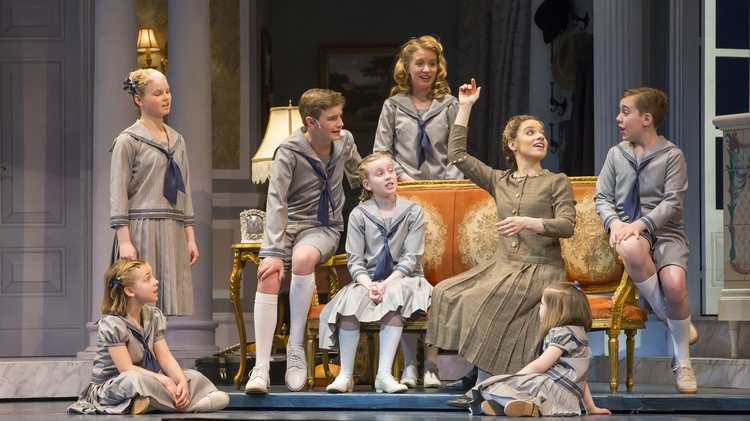
Maria and the von Trapp children in Lyric's 2013/14 production of The Sound of Music.
By late summer of 1959, The Sound of Music was in rehearsal, with Donehue directing a cast headed by the ever-lovable Martin, the exceptionally gifted Vienna-born actor-singer Theodore Bikel as the Captain, and one of America’s greatest dramatic sopranos, Patricia Neway, as the Mother Abbess. Additional authenticity came from another Vienna native, Kurt Kasznar, as Max Detweiler. During the Boston pre-Broadway tryout, Hammerstein (who was to die of cancer the following year) wrote his last lyric—“Edelweiss,” in which Bikel accompanied himself on the guitar. The show opened on Broadway on November 16, 1959, with Maria von Trapp rising to her feet to applaud when Mary Martin took her solo bow.
New York Times critic Brooks Atkinson felt the show indulged in operetta clichés, but he admired the songs and Martin’s performance. The show settled in for a 1,400-performance run and earned eight Tony Awards, including Best Musical. In 1965 came director Robert Wise’s spectacularly successful movie version, in which the onscreen romance of Julie Andrews and Christopher Plummer—as well as the glorious Salzburg location shots—captivated the world. Subsequently there have since been stage productions in literally every country in which musical theater is performed.
Of course, the show’s enduring qualities have most to do with the creators’ words and music. Ted Chapin, president and executive director of Rodgers & Hammerstein (formerly The Rodgers & Hammerstein Organization), is struck by the youthful quality that imbues so much of this score: “Songs like ‘Do Re Mi’ and ‘Sixteen Going on Seventeen’ are legitimately about children, youth, learning. Those two men in their sixties were able to tap into their creativity to write these songs in a truly genuine way.” Chapin notes, too, that “My Favorite Things” (which John Coltrane transformed into a jazz standard), “Do Re Mi,” and “The Sound of Music” are the most popular songs in the entire R&H catalogue.
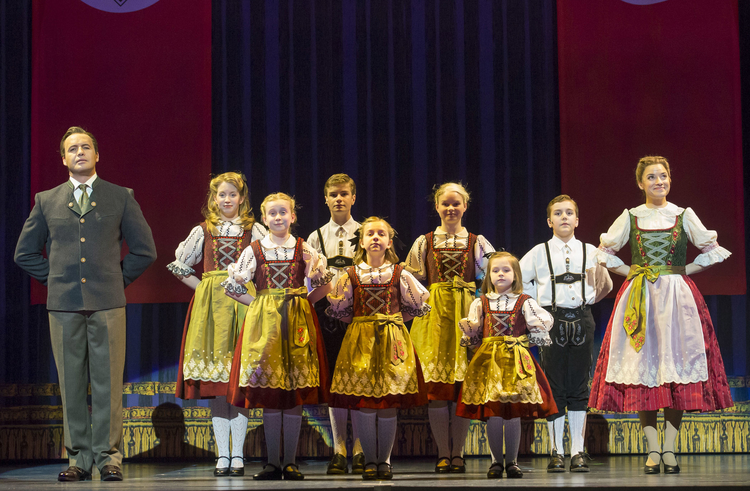
The von Trapp family in Lyric's 2013/14 production of The Sound of Music.
Anyone familiar with the Andrews/Plummer film will notice many significant differences in the stage play. The actors portraying Elsa and Max onscreen, Eleanor Parker and Richard Haydn, were not singers, and both songs involving them were cut. Onstage, however, these characterizations are notably enhanced by the songs: “How Can Love Survive?” (a duet lamenting the difficulties rich people experience in uniting with each other romantically) and “No Way to Stop It” (a trio that finds the two attempting to persuade Georg to bend with the times and let the German invasion of Austria blow over). Lyric’s production incorporated two songs, written by Richard Rodgers especially for the film: Maria’s “I Have Confidence,” anticipating her arrival at the villa; and “Something Good,” her touching duet with Georg.
Movie audiences who see the play onstage are invariably surprised that “My Favorite Things” is actually sung by Maria at the request of the Mother Abbess, who then sings it back to her. In Maria’s bedroom it isn’t that song, but rather, “The Lonely Goatherd” that she sings to distract the children from the storm outside. The stage version also gives greater attention to Georg’s conflict with the Germans. Certainly in the realm of musical theater no one in the 1950s was choosing to deal with the horrific events of the Nazi era (Cabaret on Broadway was still seven years in the future)."Certainly The Sound of Music was the first musical that dealt with this in any way,” comments Chapin.
To do a musical that had the Third Reich as the overview was pretty bold. For those who think The Sound of Music is nothing but sweetness and light, there’s politics—this is the first musical that has the Holocaust over its shoulder. It’s not just fluff and whiskers on kittens.
The cumulative dramatic power in the show’s second half is due largely to the work of Lindsay and Crouse. We generally speak of “Rodgers and Hammerstein’s The Sound of Music,” but this was a creative collaboration between four savvy men of the theater, not two. Timothy Crouse, Russel’s son, has written of the piece as “one of the leanest and most solidly constructed of all musicals, in which every line and note contribute to the thrust of the dramatic arc.” In admiring the compactness of The Sound of Music, Crouse cites in particular Elsa’s line from her last scene: “There’s one thing you do better here than we do in Vienna—your sunsets. I’m going to miss them.” Here we have, as Crouse says, “a breakup in nineteen words: a miracle of concision.”
The Sound of Music presents the journey of a uniquely appealing young woman, who uses music as her means to bring an emotionally absent father together with his children. Along the way Maria finds love with Georg, and as darkness and evil invade Austria, Maria’s resourcefulness and courage buoy her newfound family as they leave their home to start a new life. All of this is accomplished through music and words that have never lost their freshness, their charm, or their power to inspire.
Photos: Todd Rosenberg
